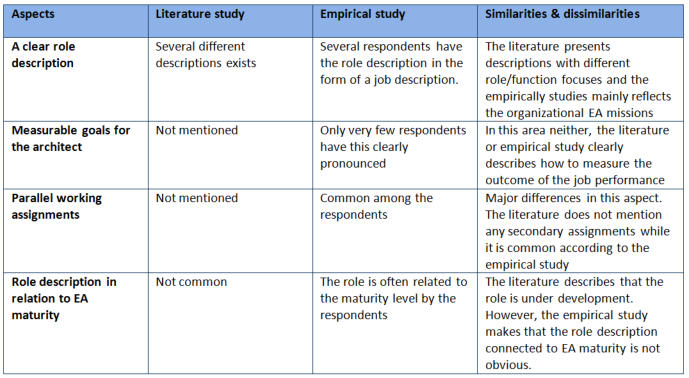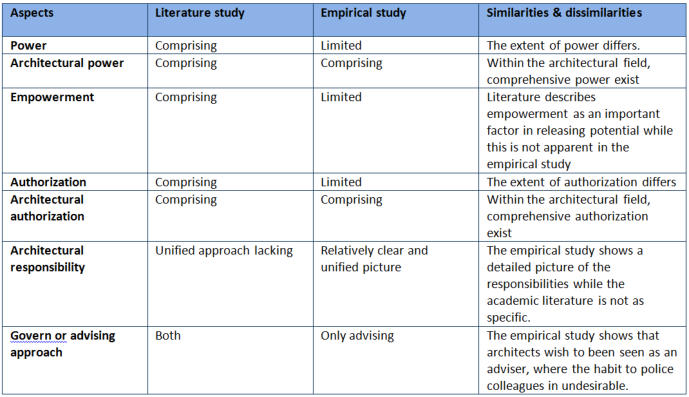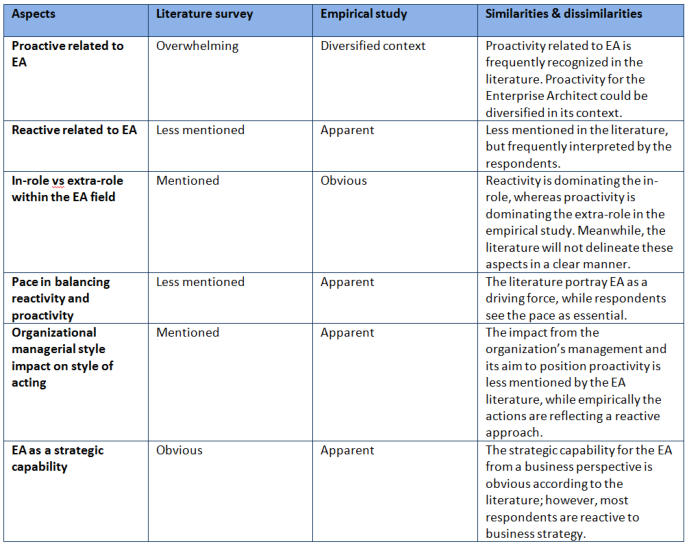

Research Analysis and Discussion
Below analysis aims to highlight the comparison between how the EA profession is described in the academic literature and revealed by the empirical study. The analysis is based on a comparative analysis method with the purpose to provide a thorough comparative evaluation of the selected five topics. In each topic, the most significant and interesting aspects are studied. Each of these aspects is elucidated with the result from the literature and the empirical study where similarities and dissimilarities for each aspect are described.The Role
With the background of this study to compare the literature with empirical data, the professional's role description is studied from an academic and a practical point of view with the purpose of determine characterizing representations and to distinguish the main ambition of the profession. There are no legal or regulatory criteria that define the role, and the literature describes the role from different perspectives, but there are quite a lot written about the role with a focus on different functions such as change agent and negotiator. The empirical study shows that the role of the description most often is based on the decomposition of the company's EA initiative and a mission such as establish and maintain the strategic direction of methodologies, standards, best practices and governance for IT Management. In order to study a profession, it may seem applicable to examine whether there are any measurable targets for the outcomes of the work output. Neither the academic nor the empirical study can show that there exist any such tools or key performance indicators (KPIs). The empirical study shows however that there are great interest and need for such a tool. Many respondents connect this deficiency to that the organization's EA is immature such measurement tool. The academic literature does not mention that it is common with other sideline activities in the role that the empirical study clearly shows. This is a most interesting finding that can be interpreted that a clearer and narrower role description could support that all the performed activities can be found in the description. The literature describes that the role is under development but the link as the empirical study makes it connected to EA maturity, is not obvious. The empirical study describes the respondents’ consider that the role description is highly dependent on the organization’s achieved EA maturity, and a maturity intensification would benefit the role description. Table 1. Comparison of aspects regarding the role.The Competence
When comparing the literature with the empirical research on required skills and competence of the Enterprise Architect, there are many similarities in the descriptions although it exist some inconsistencies between them. Regarding the aspect of what constitutes core competencies of the profession, the literature and the empirical study agrees on high skills in information modelling and service design. Both mean that cooperation and communication skills at different levels are the most central knowledge for the profession. Although the literature rarely describes what this knowledge should be used for, the empirical study shows that this knowledge in many cases can be criticized for how well the EA mission can be promoted the organization. Several researchers mention Change Management as a core competence while none of the respondents expressed this as an essential skill. This could be interpreted, as the architects are not primarily considering themselves as responsible for problem solving, rather as focusing on being a team member assisting others during the change process. Being a good leader is described as a central skill in the literature. The empirical study shows that understanding the organization's formal and informal decision-making process is rather important to perform successfully within the profession. In neglecting these decision-making paths, the possibility to influence the appropriate stakeholders in the organization may decline. Both the literature and the empirical study describe continuous acquisition of knowledge through academic studies: participate in forums; read trade magazines; visiting fairs and collegial networking as important to be able to perform and to keep up to date with developments in the EA field. Both the literature and the empirical study show that the knowledge of modeling and interpreting models are important for the profession, but the two differ on the importance of holding a certification within frameworks. The empirical study shows that it is not important to certify the frameworks’ skills while the literature rather frequently mentions this feature. Table 2. Comparison of aspects regarding the competencies.The Power
When comparing the power as aspects of the profession, the terms of capacities of authorization, responsibility, and obtainable resources are compared with the academic literature and the empirical research. The literature describes the architect's power relatively extensively with a considerable empowerment to make decisions that affect many different stakeholders and business functions. The empirical study shows that this freedom is not quite as comprising when it comes to the power to execute these decisions. In many cases, the full power only exists within the architectural field and when it affects the organization's major assignments, the architect's power is of an advisory nature only. The literature describes the profession's mission as to govern while the empirical study shows that the architects do not want to be associated to police their colleagues, permitting authorization or actively searching for scapegoats. The literature provides no coherent picture of the profession's responsibility while the empirical study shows that the interviewed architects are well aware of what responsibility domains they are expected to operate within. The mentioned responsibilities often affect tasks such as developing a common vocabulary, supporting data modelling, and turning information models into service designs in dialogue with other architects and stakeholders. Table 3. Comparison of aspects regarding the power.The Style of Acting
The drive for this section is to compare the literature with the empirical research on the characteristics of the style of acting representing the style of the Enterprise Architect in their profession, acting proactively or reactively. While the literature widely expresses proactivity in the context of EA, those statements cannot be confirmed by the empirical study. One adverse attribute noted from the EA reference literature is that the definition of the proactive or reactive approach seldom is declared. However, the majority of the EA literature is considered the EA in the light of a proactive approach, the majority of the respondents obey the proactive approach; nonetheless, the every-day assignments will force the architect to behave reactively upon daily issues and tasks. Still, the EA literature depicts EA as the engine for the future to come, the empirical study of this subject reveals the necessity for the successful Enterprise Architect to esteem temporal dynamics and pace in interaction with their colleagues. The organizational, managerial style will influence the approach from its followers. Thus, the Enterprise Architect will behave according to what is expected from their superiors (vertical collaboration), moreover in the relationship with other, not superior, roles within the EA context (horizontal collaboration). The impact of the executives’ leadership on the style of acting, is rarely considered by the EA literature, but found with an apparent bias towards reactive in practice by this study. The strategic capability from EA is evident in the literature. To a certain degree, it appears obvious to the respondents about the strategic capability derived from EA work, whereas according to the respondents, the organization does not share the very same opinion. As the interpretation, a great portion of the respondents delineates their approach to business strategy as reactive. One effort in determination the proactivity and reactivity for the Enterprise Architect’s position, is to correlate these approaches towards if the architect’s actions are considered to be in-role or as extra-role behavior. The empirical study shows that the in-role proactivity could classify a particular action to keep in contact with change initiatives in an effort to inform the team members about the EA principles or supportive function during the project’s lifecycle. The in-role reactivity approach may express a repetitively EA strategy derived from the enterprise business strategy, expressed by the respondents, despite EA is considered as a strategic capability. The extra-role proactivity approach could be interpreted by the respondents’ aim in selling the benefits derived from EA to their colleagues while the extra-role reactivity approach is to police the very same colleagues on noncompliance regarding EA principles. Table 4. Comparison of aspects regarding the style of acting.The Main Focus
This section will cover the comparison revealed from the EA literature and matched to the very same characteristics of the respondents to this study regarding the Enterprise Architect’s main focus reflecting the balance of the business and IT domains’ issues. The general understanding revealed from the literature is that the Enterprise Architect is intended to act as a pilot to deliver guidance to the organization, the senior management, as well as the project members in trouble waters, providing architectural experiences and technological knowledge aiming to smooth the free paths, preventing the followers from get stranded. Despite this decent approach, the majority of respondents to this study express a certain hesitation to be prompted readily, thus asked for upon request, regularly when tasks have failed. The balance of business knowledge and a core IT experience is mentioned in the literature, however quite apparently pronounced by this study’s respondents. Several respondents prompt the consumption of calendar time to convince the organization about the value derived from EA as central while this time factor seldom is perceived in the literature. While the EA literature expects value to be derived from EA, the empirical study, described in this study’s paper 2, depicts an Enterprise Architect that seldom is reviewed on EA related measurements, nor have a clear assignment associated with evaluating measures. Sometimes the efforts from the Enterprise Architect are going out of control ending up with the ivory tower of EA, in a dogmatic manner, neglecting the business value derived from EA. One interesting finding is the observation revealed from the interviews that the organizational compliance to EA principles is quite good upon the average project’s effort to respect the EA guidelines. However, enterprise-wide change and transition programs is considered by most organizations as the subject for (top) management discretion only, where the EA principles and guidelines are overruled without further notice. In this light, EA as the strategic capability frequently mentioned in the literature, although implicitly, could be questioned. This observation is reinforced by the circumstance that regular meetings between the senior management and the EA representatives are rare. The majority of the respondents have never met the top executive / CEO in a face-to-face meeting. By this observation, strategic alignment, frequently appealed to by the EA literature, is to be questioned in reality. Table 11. Comparison of aspects regarding the main focus.The Analysis in Summary
This analysis aims to highlight the comparison on how the EA profession is described in the academic literature and revealed by the empirical study. The result of this analysis can be summarized by that the literature and empirical findings in many respects corresponds well while it is markedly different in some points. Examples of where the two studies differs, can be termed as when the literature describes that the role is under development, but the link as the empirical study makes it connected to EA maturity is not obvious in the academic literature. On the one hand, the empirical study shows relationships and consequent effects that could not be found in the literature where the discovery of the connection between the role description and the organizational EA maturity was made. On the other hand, the literature describes certain aspects that are not revealed in the empirical study such as change management is an important ingredient and competence for the professionals while this knowledge is not revealed in the empirical study. Cases in which the two different studies broadly agree and their results are in harmony can be exemplified by the result they both consider the most important skills are to comprehend the business, and the communication skills.




The Enterprise Architect - Research Analysis and Discussion
External links:
Rolf Olsson | ITM-Studier | Tingens internet (internet of things) | Affärsnyttan
© Enterprise Architect, 2015.
Version 0.27, 2015-10-11

























